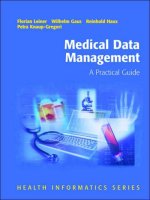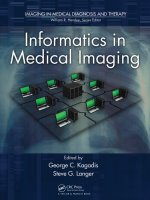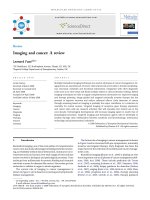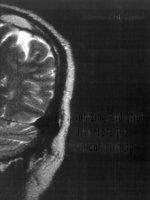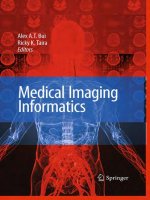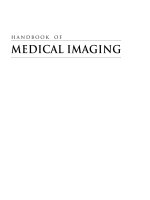Medical Imaging Informatics docx
Bạn đang xem bản rút gọn của tài liệu. Xem và tải ngay bản đầy đủ của tài liệu tại đây (8.41 MB, 562 trang )
Medical Imaging Informatics
Medical Imaging
Informatics
Alex A.T. Bui, Ricky K. Taira (eds.)
Editors
Alex A.T. Bui Ricky K. Taira
Medical Imaging Informatics Group Medical Imaging Informatics Group
Department of Radiological Sciences Department of Radiological Sciences
David Geffen School of Medicine David Geffen School of Medicine
University of California, Los Angeles University of California, Los Angeles
924 Westwood Blvd. 924 Westwood Blvd.
Los Angeles, CA 90024 Los Angeles, CA 90024
Suite 420 Suite 420
USA USA
ISBN 978-1-4419-0384-6 e-ISBN 978-1-4419-0385-3
DOI 10.1007/978-1-4419-0385-3
Springer New York Dordrecht Heidelberg London
© Spri
nger Science+Business Media, LLC 2010
All rights reserved. This work may not be translated or copied in whole or in part without the written per-
mission of the publisher (Springer Science+Business Media, LLC, 233 Spring Street, New York, NY 10013,
USA), except for brief excerpts in connection with r
e
views or scholarly analysis. Use in connection with any
form of information storage and retrieval, electronic adaptation, computer software, or by similar or dissimila
r
methodology now known or hereafter developed is forbid
den.
The use in this publication of trade names, trademar
ks, service marks, and similar terms, even if they are not
identified as such, is not to be taken as an expression of opinion as to whether or not they are subject to
pr
oprietary rights.
While the advice and information in this book are believed to be true and accurate at the dat
e
of going to
press, neither the authors nor the editors nor the publisher can accept any legal responsibility for any errors
or omissions that may be made. The publisher makes no warranty, express or implied, with respect to the
material contained herein.
Printed on acid-free paper
Springer is part of Springer Science+Busi
nes
s Media (www.springer.com)
Library of Congress Control Number: 2009939431
For our mentor and friend, Hoosh, who has the wisdom and leadership to realize a
vision; and to our students past, present, and future, for helping to pave a path
forward.
vii
Foreword
Imaging is considered as one of the most effective – if not the most effective – in vivo
sampling techniques applicable to chronic serious illnesses like cancer. This simple yet
comprehensive textbook in medical imaging informatics (MII) promotes and facili-
tates two different areas of innovation: the
innovations in technology that improve the
field of biomedical informatics itself; and the application of these novel technologies
to medicine, thus, improving health. Aside from students in imaging disciplines such
as radiological sciences (vs. radiology as a service), this book is also very pertinent to
other disciplines such as cardiology and surgery. Faculty and students familiar with
this book will come to have their own ideas how to innovate, whether it be in core
technologies or in applications to biomedicine.
Organizationally, the book follows a very sensible structure related to the process of
care, which can in principle be summarized in three questions: what is wrong; how
serious is it; and what to do? The first question (what is wrong) focuses mostly on
diagnosis (i.e., what studies should be obtained). In this way, issues such as individu-
ally-tailored image protocol selection are addressed so that the most appropriate and
correct study is obtained – as opposed to the traditional sequential studies. For example,
a patient with knee pain and difficulty going up stairs or with minor trauma to the knee
and evidence of effusion is directly sent for an MRI (magnetic resonance imaging)
study rather than first going to x-ray; or in a child suspected of having abnormal (or
even normal) brain development, MRI studies are recommended rather than traditional
insurance-required computed tomography (CT). The role of imaging, not only in
improving diagnosis but reducing health costs is highlighted. The second question
(how serious is it) relates to how we can standardize and document image findings, on
the way to providing truly objective, quantitative assessment from an imaging study as
opposed to today’s norm of largely qualitative descriptors. Finally, the third question
is in regard to how we can act upon the information we obtain clinically, from imaging
and other sources: how can decisions be made rationally and how can we assess the
impact of either research or an intervention?
The textbook has been edited by two scientists, an Associate Professor and a Professor
in MII who are both founders of this discipline at our institution. Contributions come
from various specialists in medical imaging, informatics, computer science, and bio-
statistics. The book is not focused on image acquisition techniques or image process-
ing, which are both well-known and described elsewhere in other texts; rather, it
focuses on how to extract knowledge and information from imaging studies and
related data. The material in this textbook has been simplified eloquently, one of the
most difficult tasks by any teacher to simplify difficult material so that it is under-
standable at all levels.
viii Foreword
In short, this textbook is highly recommended for students in any discipline dealing
with imaging as well as faculty interested in disciplines of medical imaging and
informatics.
Hooshang Kangarloo, MD
Professor Emeritus of Radiological Sciences, Pediatrics, and Bioengineering
University of California at Los Angeles
With the advancement of picture archiving and communications systems (PACS) into
“mainstream” use in healthcare facilities, there is a natural transition from the dis-
ciplines of engineering research and technology assessment to clinical operations.
While much research in PACS-related areas continues, commercial systems are
widely available. The burgeoning use of PACS in a range of healthcare facility sizes
has created entirely new employment opportunities for “PACS managers,” “modality
managers,” “interface analysts,” and others who are needed to get these systems
implemented, keep them operating, and expand them as necessary. The field of medical
imaging informatics is often described as the discipline encompassing the subject
areas that these new specialists need to understand. As the Society of Imaging Infor-
matics in Medicine (SIIM) defines it:
Imaging informatics is a relatively new multidisciplinary field that intersects
with the biological sciences, health services, information sciences and com-
puting, medical physics, and engineering. Imaging informatics touches every
aspect of the imaging chain and forms a bridge with imaging and other
medical disciplines.
1
Because the technology of PACS continues to evolve, imaging informatics is also
important for the researcher. Each of the areas comprising the field of imaging infor-
matics has aspects that make for challenging research topics. Absent the research these
challenges foster and PACS would stagnate.
For the student of medical imaging informatics, there is a wealth of literature available
for study. However, much of this is written for trainees in a particular discipline.
Anatomy, for example, is typically aimed at medical, dental, veterinary, and physical
therapy students, not at engineers. Texts on networks or storage systems are not
designed for physicians. Even primers on such topics tend not to provide a cross-
disciplinary perspective of the subject.
1
Society of Imaging Informatics in Medicine website: .
Foreword ix
The authors of Medical Imaging Informatics have accepted the challenge of creating a
textbook that provides the student of medical imaging informatics with the broad
range of topical areas necessary for the field and doing so without being superficial.
Unusual for a text on informatics, the book contains a chapter, A Primer on Imaging
Anatomy and Physiology, subject material this writer knows is important, but is often
lacking in the knowledge-base of the information technology (IT) people he works
with. Similarly, many informatics-oriented physicians this writer knows do not have
the in-depth understanding of information systems and components that IT experts
have. Such is the subject matter of the “middle” chapters of the book – Chapter 3:
Information Systems & Architectures, Chapter 4: Medical Data Visualization: Toward
Integrated Clinical Workstations, and Chapter 5: Characterizing Imaging Data. The
succeeding chapters are directed towards integrating IT theory and infrastructure with
medical practice topics – Chapter 6: Natural Language Processing of Medical Reports,
Chapter 7: Organizing Observations: Data Models, Chapter 8: Disease Models, Part I:
Graphical Models, and Chapter 9: Disease Models, Part II: Querying & Applications.
Finally, because a practitioner of medical imaging informatics is expected to keep up
with the current literature and to know the bases of decision making, the authors have
included a chapter on Evaluation. With the statistical methods and technology assess-
ment areas covered, the reader will gain the understanding needed to be a critical
reader of scientific publications and to understand how systems are evaluated during
development and after deployment.
Structured in this way, this book forms a unique and valuable resource both for the
trainee who intends to become an expert in medical imaging informatics and a refer-
ence for the established practitioner.
Steven C. Horii, MD, FACR, FSIIM
Professor of Radiology,
Clinical Director, Medical Informatics Group, and
Modality Chief for Ultrasound
Department of Radiology
University of Pennsylvania Medical Center
xi
Preface
This book roughly follows the process of care, illustrating the techniques involved in
medical imaging informatics. Our intention in this text is to provide a roadmap for the
different topics that are involved in this field: in many cases, the topics covered in the
ensuing chapters are themselves worthy of lengthy descriptions, if not an entire book.
As a result, when possible the authors have attempted to provide both seminal and
current references for the reader to pursue additional details.
For the imaging novice and less experienced informaticians, in Part I of this book,
Performing the Imaging Exam, we cover the current state of medical imaging and set
the foundation for understanding the role of imaging and informatics in routine clinical
practice:
Chapter 1 (Introduction) provides an introduction to the field of medical imaging
informatics and its role in transforming healthcare research and delivery. The
interwoven nature of imaging with preventative, diagnostic, and therapeutic elements
of patient care are touched upon relative to the process of care. A brief historic
perspective is provided to illustrate both past and current challenges of the discipline.
Chapter 2 (An Introduction to Imaging Anatomy & Physiology) starts with a
review of clinical imaging modalities (i.e., projectional x-ray, computed tomography
(CT), magnetic resonance (MR), ultrasound) and a primer on imaging anatomy
and physiology. The modality review encompasses core physics principles and
image formation techniques, along with brief descriptions of present and future
directions for each imaging modality. To familiarize non-radiologists with medical
imaging and the human body, the second part of this chapter presents an overview
of anatomy and physiology from the perspective of projectional and cross-
sectional imaging. A few systems (neurological, respiratory, breast) are covered in
detail, with additional examples from other major systems (gastrointestinal,
urinary, cardiac, musculoskeletal).
More experienced readers will likely benefit from starting with Part II of this book,
Integrating Imaging into the Patient Record, which examines topics related to
communicating and presenting imaging data alongside the growing wealth of clinical
information:
Once imaging and other clinical data are acquired,
Chapter 3 (Information Systems
& Architectures) tackles the question of how we store and access imaging and
other patient information as part of an increasingly distributed and heterogeneous
EMR. A description of major information systems (e.g., PACS; hospital informa-
tion systems, HIS; etc.) as well as the different data standards employed today to
represent and communicate data (e.g., HL7, DICOM) are provided. A discussion
xii Preface
of newer distributed architectures as they apply to clinical databases (peer-to-peer,
grid computing) and information processing is given, examining issues of scal-
ability and searching. Different informatics-driven applications are used to high-
light ongoing efforts with respect to the development of information architectures,
including telemedicine, IHE, and collaborative clinical research involving imaging.
After the data is accessed, the challenge is to integrate and to present patient
information in such a way to support the physician’s cognitive tasks. The longitud-
inal EMR, in conjunction with the new types of information available to clinicians,
has created an almost overwhelming flow of data that must be fully understood to
properly inform decision making. Chapter 4 (Medical Data Visualization:
Toward Integrated Clinical Workstations) presents works related to the visualiz-
ation of medical data. A survey of graphical metaphors (lists and tables; plots and
charts; graphs and trees; and pictograms) is given, relating their use to convey
clinical concepts. A discussion of portraying temporal, spatial, multidimensional,
and causal relationships is provided, using the navigation of images as an example
application. Methods to combine these visual components are illustrated, based on
a definition of (task) context and user modeling, resulting in a means of creating
an adaptive graphical user interface to accommodate the range of different user
goals involving patient data.
Part III, Documenting Imaging Findings, discusses techniques for automatically
extracting content from images and related data in order to objectify findings:
In Chapter 5 (Characterizing Imaging Data), an introduction to medical image
understanding is presented. Unlike standard image processing, techniques within
medical imaging informatics focus on how imaging studies, alongside other clinical
data, can be standardized and their content (automatically) extracted to guide
medical decision making processes. Notably, unless medical images are standard-
ized, quantitative comparisons across studies is subject to various sources of bias/
artifacts that negatively influence assessment. From the perspective of creating
scientific-quality imaging databases, this chapter starts with the groundwork for
understanding what exactly an image captures, and commences to outline the dif-
ferent aspects encompassing the standardization process: intensity normalization;
denoising; and both linear and nonlinear image registration methods are covered.
Subsequently, a discussion of commonly extracted imaging features is given,
divided amongst appearance- and shape-based descriptors. With the wide array of
image features that can be computed, an overview of image feature selection and
dimensionality reduction methods is provided. Lastly, this chapter concludes with
a description of increasingly popular imaging-based anatomical atlases, detailing
their construction and usage as a means for understanding population-based
norms and differences arising due to a disease process.
Preface xiii
Absent rigorous methods to automatically analyze and quantify image findings,
radiology reports are the sole source of expert image interpretation. In point of
fact, a large amount of information about a patient remains locked within clinical
documents; and as with images, the concepts therein are not readily computer un-
derstandable. Chapter 6 (Natural Language Processing of Medical Reports)
deals with the structuring and standardization of free-text medical reports via
natural language processing (NLP). Issues related to medical NLP representation,
computation, and evaluation are presented. An overview of the NLP task is first
described to frame the problem, providing an analysis of past efforts and applica-
tions of NLP. A sequence of subtasks is then related: structural analysis (e.g., section
and sentence boundary detection), lexical analysis (e.g., logical word sequences,
disambiguation, concept coding), phrasal chunking, and parsing are covered. For
each subtask, a description of the challenges and the range of approaches are
given to familiarize the reader with the field.
Core to informatics endeavors is a systematic method to organize both data and
knowledge, representing original (clinical) observations, derived data, and conclu-
sions in a logical manner. Chapter 7 (Organizing Observations: Data Models)
describes the different types of relationships between healthcare entities, particularly
focusing on those relations commonly encountered in medical imaging. Often in
clinical practice, a disease is studied from a specific perspective (e.g., genetic,
pathologic, radiologic, clinical). But disease is a phenomenon of nature, and is thus
typically multifaceted in its presentation. The goal is to aggregate the observations
for a single patient to characterize the state and behavior of the patient’s disease,
both in terms of its natural course and as the result of (therapeutic) interventions.
The chapter divides the organization of such information along spatial (e.g.,
physical and anatomical relations, such as between objects in space), temporal
(e.g., sequences of clinical events, episodes of care), and clinically-oriented
models (i.e., those models specific to representing a healthcare abstraction).
A discussion of the motivation behind what drives the design of a medical data
model is given, leading to the description of a phenomenon-centric data model to
support healthcare research.
Finally, in Part IV, Toward Medical Decision Making, we reflect on issues pertain-
ing to reasoning with clinical observations derived from imaging and other data
sources in order to reach a conclusion about patient care and the value of our decision:
A variety of formalisms are used to represent disease models; of these, probabilistic
graphical models have become increasingly popular given their ability to reason
in light of missing data, and their relatively intuitive representation. Chapter 8
(Disease Models, Part I: Graphical Models) commences with a review of key
concepts in probability theory as the basis for understanding these graphical models
xiv Preface
and their different formulations. In particular, the first half of the chapter handles
Bayesian belief networks (BBNs), appraising past and current efforts to apply
these models to the medical environment. The latter half of this chapter addresses
the burgeoning exploration of causal models, and the implications for analysis and
positing questions to such networks. Throughout, a discussion of the practical
considerations in the building of these models and the assumptions that must be
made, are given.
Following the discussion of the creation of the models, in Chapter 9 (Disease
Models, Part II: Querying & Applications), we address the algorithms and tools
that enable us to query BBNs. Two broad classes of queries are considered: belief
updating, and abductive reasoning. The former entails the re-computation of pos-
terior probabilities in a network given some specific evidence; the latter involves
calculating the optimal configuration of the BBN in order to maximize some
specified criteria. Brief descriptions of exact and approximate inference methods
are provided. Special types of belief networks (naïve Bayes classifiers, influence
diagrams, probabilistic relational models) are covered, illustrating their potential
usage in medicine. Importantly, issues related to the evaluation of belief networks
are discussed in this chapter, looking to standard technical accuracy metrics, but
also ideas in parametric sensitivity analysis. Lastly, the chapter concludes with
some example applications of BBNs in medicine, including to support case-based
retrieval and image processing tasks.
Chapter 10 (Evaluation) concludes by considering how to assess informatics
endeavors. A primer on biostatistics and study design starts this chapter, including
a review of basic concepts (e.g., confidence intervals, significance and hypothesis
testing) and the statistical tests that are used to evaluate hypotheses under differ-
ent circumstances and assumptions. A discussion of error and performance
assessment is then introduced, including sensitivity/specificity and receiver opera-
tive characteristic analysis. Study design encompasses a description of the differ-
ent types of experiments that can be formed to test a hypothesis, and goes over the
process of variable selection and sample size/power calculations. Sources of study
bias/error are briefly described, as are statistical tools for decision making. The
second part of this chapter uses the foundation set out by the primer to focus
specifically on informatics-related evaluations. Two areas serve as focal points:
evaluating information retrieval (IR) systems, including content-based image
retrieval; and assessing (system) usability.
xv
Contributors
Pablo Abbona, MD Neda Jahanshad, BS
Department of Radiological Sciences Medical Imaging Informatics
UCLA David Geffen School of Medicine UCLA Biomedical Engineering IDP
Denise Aberle, MD Hooshang Kangarloo, MD
Medical Imaging Informatics & Medical Imaging Informatics
Department of Radiological Sciences UCLA David Geffen School of Medicine
UCLA David Geffen School of Medicine
Corey Arnold, PhD Kambiz Motamedi, MD
Medical Imaging Informatics & Department of Radiological Sciences
Department of Information Studies UCLA David Geffen School of Medicine
University of California, Los Angeles
Lawrence Bassett, MD Craig Morioka, PhD
Department of Radiological Sciences Department of Radiology
UCLA David Geffen School of Medicine Veteran’s Administration Wadsworth
Los Angeles, California
Kathleen Brown, MD Nagesh Ragavendra, MD
Department of Radiological Sciences Department of Radiological Sciences
UCLA David Geffen School of Medicine UCLA David Geffen School of Medicine
Matthew Brown, PhD James Sayre, PhD
Thoracic Imaging Laboratory & Departments of Biostatistics &
Department of Radiological Sciences Radiological Sciences
UCLA David Geffen School of Medicine UCLA David Geffen School of Medicine
Suzie El-Saden, MD Leanne Seeger, MD
Department of Radiology Department of Radiological Sciences
Veteran’s Administration Wadsworth UCLA David Geffen School of Medicine
Los Angeles, California
Ana Gomez, MD Ilya Shpitser, PhD
Department of Radiological Sciences School of Public Health
UCLA David Geffen School of Medicine Harvard University
William Hsu, PhD Emily Watt, MLIS
Medical Imaging Informatics Medical Imaging Informatics
UCLA David Geffen School of Medicine UCLA Biomedical Engineering IDP
Juan Eugenio Iglesias, MSc
Medical Imaging Informatics
UCLA Biomedical Engineering IDP
xvii
Table of Contents
FOREWORD VII
P
REFACE XI
C
ONTRIBUTORS XV
T
ABLE OF CONTENTS XVII
PART
I PERFORMING THE IMAGING EXAM 1
C
HAPTER 1: INTRODUCTION 3
What is Medical Imaging Informatics? 3
The Process of Care and the Role of Imaging
4
Medical Imaging Informatics: From Theory to Application
5
Improving the Use of Imaging 5
Choosing a Protocol: The Role of Medical Imaging Informatics 7
Cost Considerations 10
A Historic Perspective and Moving Forward
11
PACS: Capturing Images Electronically 11
Teleradiology: Standardizing Data and Communications 12
Integrating Patient Data 12
Understanding Images: Today’s Challenge 13
References
14
C
HAPTER 2: A PRIMER ON IMAGING ANATOMY AND PHYSIOLOGY 17
A Review of Basic Imaging Modalities 17
Projectional Imaging
18
Core Physical Concepts 18
Imaging 20
Computed Tomography
27
Imaging 28
Additional CT Applications 39
Magnetic Resonance
41
Core Physical Concepts 41
Imaging 44
Additional MR Imaging Sequences 49
Ultrasound Imaging
53
xviii Table of Contents
An Introduction to Imaging-based Anatomy & Physiology 55
Respiratory System
56
The Larynx and Trachea 56
The Lungs and Airways 57
The Pleura, Chest Wall, and Respiratory Muscles 61
Pulmonary Ventilation: Inspiration and Expiration 62
Pressure Relationships during Inspiration and Expiration 63
Factors Influencing Airflow 63
Measures of Lung Function 65
Basic Respiratory Imaging 66
Imaging Analysis of Pulmonary Pathophysiology 68
The Brain
71
Cerebral Hemispheres 72
Cerebral White Matter 76
Basal Nuclei 76
Brainstem 77
Meninges 78
Cerebral Vascular Anatomy 78
Breast Anatomy and Imaging
80
Breast Imaging 80
Breast Cancer and other Findings 85
Musculoskeletal System
87
Imaging of the Musculoskeletal System 88
Cardiac System
94
Cardiac Medical Problems 95
Basic Cardiac and Vascular Imaging 96
Urinary System
98
Basic Imaging of the Urinary System 99
Urinary Medical Problems 100
Upper Gastrointestinal (GI) System
103
References
105
PART
II INTEGRATING IMAGING INTO THE PATIENT RECORD 113
C
HAPTER 3: INFORMATION SYSTEMS & ARCHITECTURES 115
The Electronic Medical Record
115
EMR Information Systems
117
Hospital Information Systems 117
Picture Archive and Communication Systems 119
Table of Contents xix
Data Standards for Communication and Representation 121
DICOM (Digital Imaging and Communication in Medicine)
122
The DICOM Model 122
DICOM Extensions 126
Health Level 7 (HL7)
127
Messaging Protocol 128
Reference Implementation Model (RIM) 129
Clinical Document Architecture (CDA) 131
Logical Observation Identifier Names and Codes (LOINC)
132
Distributed Information Systems
134
Peer-to-peer Architectures
135
First Generation P2P: Centralized Searching 136
Second Generation P2P: Simple Decentralized Searching (Query Flooding) 137
Second Generation P2P: Distributed Hash Tables 139
Third Generation P2P 141
P2P Healthcare Applications 143
Grid Computing
145
Globus Toolkit 146
Condor 148
Grid Computing Healthcare Applications 149
Cloud Computing: Beyond the Grid 151
Discussion and Applications
152
Teleradiology, Telemedicine, and Telehealth
153
Integrating Medical Data Access
156
Collaborative Clinical Research: Example Image Repositories
161
References
162
C
HAPTER 4: MEDICAL DATA VISUALIZATION: TOWARD INTEGRATED CLINICAL
WORKSTATIONS 171
Navigating Clinical Data 171
Elements of the Display
172
Visual Metaphors: Emphasizing Different Relationships
183
Temporal Representations 184
Spatial Representations 188
Multidimensional Relationships 191
Causal Relationships 192
Navigating Images 194
xx Table of Contents
Combining Information: Integrating the Medical Data 199
Defining Context
200
Defining the User 200
Defining the Task: Incorporating Workflow 203
Combining Graphical Metaphors
206
Creating Integrated Displays 206
Interacting with Data 210
Imaging Workflow & Workstations
215
Discussion and Applications
219
TimeLine: Problem-centric Visualization
220
Data Reorganization 222
Visualization Dictionary 223
Patient-centric Visualization
226
References
228
PART
III DOCUMENTING IMAGING FINDINGS 241
C
HAPTER 5: CHARACTERIZING IMAGING DATA 243
What is a Pixel?
244
Representing Space, Time, and Energy
244
Mathematical Representations of Pixel Values 245
Physical Correspondence to the Real World 248
Compiling Scientific-quality Imaging Databases
250
Improving Pixel Characterization 251
Pre-acquisition: Standardizing Imaging Protocols 252
Post-acquisition: Pixel Value Calibration and Mapping 252
Dealing with Image Noise
258
Characterizing Noise 259
Noise Reduction 264
Registration: Improving Pixel Positional Characterization
269
Transformations 270
Similarity Metrics 274
Preprocessing 275
User Interaction 276
Comparison of Methods 276
Imaging Features
276
Appearance-based Image Features 277
Shape-based Image Features 281
Table of Contents xxi
Feature Selection 284
Aggregating Features: Dimensionality Reduction 285
Imaging Atlases and Group-wise Image Analysis
288
The Need for Atlases 288
Creating Atlases 289
Using Atlases 290
Morphometry 293
Discussion
296
Towards Medical Image Analysis
297
Mathematical Foundations 298
Image Modeling 299
Linking Images to Additional Knowledge 300
References
302
C
HAPTER 6: NATURAL LANGUAGE PROCESSING OF MEDICAL
R
EPORTS 317
An Introduction to Medical NLP 317
Assessment of Application Requirements
321
Overview of the Medical NLP Problem
322
Medical NLP System Components & Tasks
323
Identifying Document Structure: Structural Analysis
323
Section Boundary Detection and Classification 324
Sentence Boundary Detection 326
Tokenization 327
Defining Word Sequences 330
Named Entity Recognition and De-identification
338
Concept Coding: Ontological Mapping
341
The MetaMap Approach 342
Data Mining and Lookup-Table Caches 343
Phrasal Chunking
343
Context Modeling 345
Classifier Design 348
Generation of Training Samples 349
Linear Sequence Optimization 352
Parsing: Relation Extraction and Constituency Parsing
353
Compositionality in Language 353
Discussion
357
References
358
xxii Table of Contents
CHAPTER 7: ORGANIZING OBSERVATIONS: DATA MODELS 369
Data Models for Representing Medical Data
369
Spatial Data Models
370
Spatial Representations 370
Spatial Relationships and Reasoning 372
Anatomical and Imaging-based Models 375
Temporal Data Models
380
Representing Time 380
Temporal Relationships and Reasoning 386
Some Open Issues in Temporal Modeling 389
Clinically-oriented Views
390
Alternative Views and Application Domains 392
Discussion and Applications
393
A Phenomenon-centric View: Supporting Investigation
394
What is a Mass? An Exercise in Separating Observations from Inferences 395
PCDM Core Entities 398
Implementing the PCDM 401
References
402
PART
IV TOWARD MEDICAL DECISION MAKING 411
C
HAPTER 8: DISEASE MODELS, PART I: GRAPHICAL MODELS 413
Uncertainty and Probability 413
Why Probabilities?
414
Laws of Probability: A Brief Review 415
Probability and Change 418
Graphical Models
419
Graph Theory 420
Graphs and Probabilities 421
Representing Time 424
Graphs and Causation 425
Belief Network Construction: Building a Disease Model 428
Causal Inference
433
Causal Models, Interventions, and Counterfactuals 433
Latent Projections and their Causal Interpretation 437
Identification 438
Bayesian Belief Networks in Medicine 427
Table of Contents xxiii
Discussion and Applications 443
Accruing Sufficient Patient Data 445
Handling Uncertainty in Data 448
Handling Selection Bias 449
References
450
C
HAPTER 9: DISEASE MODELS, PART II: QUERYING & APPLICATIONS 457
Exploring the Network: Queries and Evaluation
457
Inference: Answering Queries
457
Belief Updating 458
Abductive Reasoning 465
Inference on Relational Models 468
Diagnostic, Prognostic, and Therapeutic Questions 469
Evaluating BBNs
472
Predictive Power 472
Sensitivity Analysis 474
Interacting with Medical BBNs/Disease Models
475
Defining and Exploring Structure 476
Expressing Queries and Viewing Results 477
Discussion and Applications
480
Naïve Bayes
480
Imaging Applications
482
Querying and Problem-centric BBN Visualization
483
Visual Query Interface 484
AneurysmDB 488
References
490
C
HAPTER 10: EVALUATION 497
Biostatistics and Study Design: A Primer 497
Statistical Concepts
497
Confidence Intervals 498
Significance and Hypothesis Testing 498
Assessing Errors and Performance 503
Study Design
505
Types of Study Designs 505
Study Variable Selection and Population Definition 508
Building Belief and Causal Networks: Practical Considerations 444
xxiv Table of Contents
Population Size: Sample Size and Power Calculations 510
Study Bias and Error 513
Meta-analysis 515
Decision Making
515
Regression Analysis 516
Decision Trees 517
Informatics Evaluation
518
Evaluating Information Retrieval Systems
520
Information Needs 520
Relevance 522
Evaluation Metrics 523
Medical Content-based Image Retrieval Evaluation 526
Assessing Usability
528
Evaluation Techniques 529
Discussion
535
References
536
I
NDEX 543
PART I
Performing the Imaging Exam
Wherein an introduction to medical imaging informatics (MII) is provided; as is a
review of the current state of clinical medical imaging and its use in understanding
the human condition and disease. For new students and the informatician with a
minimal background in medical imaging and clinical applications, these chapters help
provide a basis for understanding the role of MII, the present needs of physicians and
researchers dealing with images, and the future directions of this discipline.
Chapter 1 – Introduction
Chapter 2 – A Primer on Imaging Anatomy and Physiology
A.A.T. Bui and R.K. Taira (eds.), Medical Imaging Informatics, 3
DOI 10.1007/978-1-4419-0385-3_1, © Springer Science + Business Media, LLC 2010
Chapter 1
Introduction
ALEX A.T. BUI, RICKY K. TAIRA, AND HOOSHANG KANGARLOO
edical imaging informatics is the rapidly evolving field that combines
biomedical informatics and imaging, developing and adapting core methods
in informatics to improve the usage and application of imaging in healthcare;
and to derive new knowledge from imaging studies. This chapter introduces the ideas
and motivation behind medical imaging informatics. Starting with an illustration of the
importance of imaging in today’s patient care, we demonstrate imaging informatics’
potential in enhancing clinical care and biomedical research. From this perspective, we
provide an example of how different aspects of medical imaging informatics can
impact the process of selecting an imaging protocol. To help readers appreciate this
growing discipline, a brief history is given of different efforts that have contributed to
its development over several decades, leading to its current challenges.
What is Medical Imaging Informatics?
Two revolutions have changed the nature of medicine and research: medical imaging
and biomedical informatics. First, medical imaging has become an invaluable tool in
modern healthcare, often providing the only in vivo means of studying disease and the
human condition. Through the advances made across different imaging modalities,
majors insights into a range of medical conditions have come about, elucidating matters
of structure and function. Second, the study of biomedical informatics concerns itself
with the development and adaptation of techniques from engineering, computer science,
(large amounts of) electronic clinical data. Medical imaging informatics is the dis-
cipline that stands at the intersection of biomedical informatics and imaging, bridging
the two areas to further our comprehension of disease processes through the unique
lens of imaging; and from this understanding, improve clinical care.
Beyond the obvious differences between images and other forms of medical data, the
very nature of medical imaging set profound challenges in automated understanding
and management. While humans can learn to perceive patterns in an image – much as
a radiologist is trained – the nuances of deriving knowledge from an image still defy
the best algorithms, even with the significant strides made in image processing and
M
Biomedical informatics is transforming the manner by which we deal and think with
and other fields to the creation and management of medical data and knowledge.
4 A.A.T. Bui et al.
Figure 1.1: The process of care can be roughly summarized in three stages: 1) what is
wrong,
which entails identifying the problem and establishing a differential diagnosis;
2) how serious is it, which involves testing the differential diagnosis and determining
the extent of the problem; and 3) what to do, which based on analysis of test results,
concludes with a treatment decision.
computer vision. Imaging informatics research concerns itself with the full spectrum
of low-level concepts (e.g., image standardization; signal and image processing) to
higher-level abstractions (e.g., associating semantic meaning to a region in an image;
visualization and fusion of images) and ultimately, applications and the derivation of
new knowledge from imaging. Notably, medical imaging informatics addresses not
only the images themselves, but encompasses the associated data to understand the
context of the imaging study; to document observations; and to correlate and reach
new conclusions about a disease and the course of a medical problem.
The Process of Care and the Role of Imaging
From a high-level perspective, the healthcare process can be seen in terms of three
clinical questions (Fig. 1.1), each related to aspects of the scientific method. For a
given patient, a physician has to: 1) ascertain what is wrong with the patient (identify
the problem, develop a hypothesis); 2) determine the seriousness of a patient’s con-
dition by performing diagnostic procedures (experiment); and 3) after obtaining all
needed information, interpret the results from tests to reach a final diagnosis and
initiate therapy (analyze and conclude). At each point, medical imaging takes on a
critical role:
1. What is wrong
? Patient presentation, for the most part, is relatively subjective.
For example, the significance of a headache is usually not clear from a patient’s
description (e.g., my head throbs). Imaging plays a major role in objectifying
clinical presentations (e.g., is the headache secondary to a brain tumor, intra-
cranial aneurysm, or sinusitis?) and is an optimal diagnostic test in many cases to
relate symptoms to etiology. In addition, when appropriately recorded, imaging
serves as the basis for shared communication between healthcare providers,
detailing evidence of current and past medical findings.
1 Introduction 5
2. How serious is it? For many conditions, the physical extent of disease is visually
apparent through imaging, allowing us to determine how far spread a problem has
become (e.g., is it confined to a local environment or is it systemic?). Moreover,
imaging is progressively moving from qualitative to quantitative assessment.
Already, we use imaging to document physical state and the severity of disease:
tumor size in cancer patients; dual energy x-ray absorptiometry (DXA) scores in
osteoporosis; cardiothoracic ratios; arterial blood flow assessment based on
Doppler ultrasound; and coronary artery calcification scoring are all rudimentary
metrics that quantify disease burden. On the horizon are more sophisticated
quantitative imaging techniques that further characterize biophysical phenomena.
3. What to do
? Treatment is contingent on an individual’s response: if a given drug
or intervention fails to have the desired effect, a new approach must be taken to
resolve the problem. For many diseases, response assessment is done through
imaging: baseline, past, and present studies are compared to deduce overall
behavior. By way of illustration, many of today’s surgical procedures are assessed
on a follow-up imaging study; and the effects of chemotherapy are tracked over
time (e.g., is the tumor getting smaller?). Additionally, contemporary image-
guided interventional techniques are opening new avenues of treatment.
As the ubiquity and sophistication of imaging grows, methods are needed to fully real-
ize its potential in daily practice and in the full milieu of patient care and medical
research. The study of medical imaging informatics serves this function.
Medical Imaging Informatics: From Theory to Application
There are two arms to medical imaging informatics: the development of core informatics
theories and techniques that advance the field of informatics itself; and the translation
of these techniques into an application that improves health. To demonstrate, we first
consider the reasons for the improper use of imaging today, and then how imaging
informatics can impact these issues.
Improving the Use of Imaging
The process of providing an accurate, expedient medical diagnosis via imaging can
fail for several reasons (Fig. 1.2):
Sub-optimal study selection
. The first potential point of failure arises when an
imaging study is requested. Given the fairly rapid changes across all elements of
imaging technology, it is unrealistic to believe that a physician can always make
up-to-date if not optimal decisions about an imaging exam [9]. Thus, the wrong
study may be requested for a given patient. To reduce this problem, practice
guidelines have been introduced, but are often generic and do not take into
account the specific condition of the patient.



